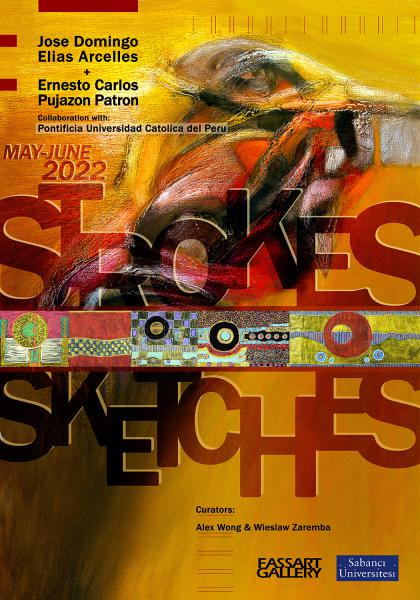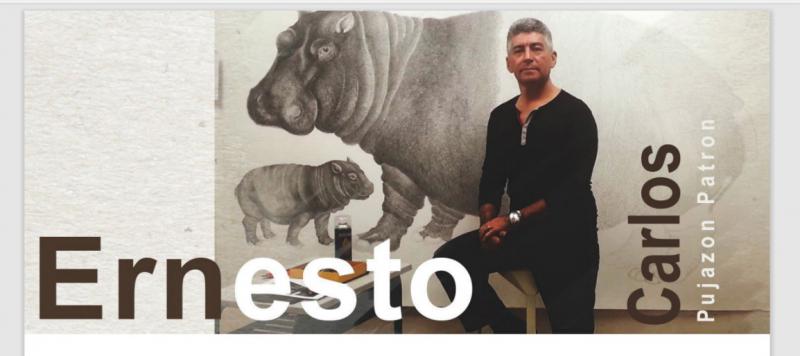New Exhibition: Strokes and Sketches
Historically, the human activity of mark making (painting, drawing and sketching) has served to describe or represent a visual language that attempts to help humankind make sense of the world around them. Not only that, drawing leaves the humans marks and traces for future generations, recording their lifestyle, culture, and the development of the human mind. Drawing as a visual language has been used throughout the millennia. Prehistoric people used burned pieces of wood or a red powder (pigments) from the surrounding stones and floras as a source to draw lines and make marks on the walls of their dwellings. They wanted to record their existence and lives. This desire resides in the deepest part of our human DNA. Such human activity is part of our sense of human mortality; it serves our ability to perceive or think visually.
The linear perspective is a system of creating an illusion of depth on a flat surface. Using this system, all parallel lines (orthogonal) in a painting or drawing converge in a single vanishing point on the composition’s horizon line. Linear perspective was likely evident to artists and architects in the ancient Greek and Roman periods. However, such practice was thus lost until the 15th century without any clear evidence. Nevertheless, their artistic endeavours are well recorded, such as mosaics, pottery, and sculpture. Prominent artists, designers, and men of science and religion used drawing to advance human knowledge. Drawing has been applied to and used in arts and sciences (artistic, scientific and technical fields of expertise).
Drawing plays a significant role in our cognitive development. It can help us learn to write and think creatively, develop hand-eye coordination, hone analytic skills, and conceptualise ideas. Hence, cognitive analysis allows the artists to make the best possible imaginary studies before implementing them. The colour arrangement creates a strong, energetic, and vigorous visual outcome. Sometimes the process and intervention in art creation depict a hidden meaning that is difficult to justify, leaving the final understanding of this visual language that allows viewers to reach their conclusions.
Ernesto’s series of sketches with abstract motifs serve as a personal interpretation and drawings of the cosmic elements. These sketches portray the Inca culture (which expanded from the North of Colombia to the South of Argentina and from the East of Brazil to the West of the Pacific Ocean); the sun, moon, mountains, rivers, sky, and the vast Peruvian landscape. On the other hand, Jose’s paintings (Abstract Expressionism) depicted and drew references from the Sican culture (Dated 700-1300), which mean “temple of the moon” or Lambayeque culture, after the name of the region in Peru. The contemporary, bold and expressive strokes aim to study the symbiotic representation of Sican art and heritage.
This exhibition collaborates between Sabancı University, Taylor’s University (CODA Gallery), Malaysia and Pontifical Catholic University of Peru (PUCP), where several talks and lectures from the university professors are held online during the pandemic (2020-2022). We hope to continue such fruitful academic activity and exchange in the coming years.


José Domingo Elías
He obtained a Master (MA) in History, Postgraduate School, Pontifical Catholic University of Peru (PUCP). Bachelor of Art with a mention in Painting, Faculty of Art and Design, PUCP. Assistant Professor in Department of Statistics, Demography, Humanities and Social Sciences, Faculty of Sciences and Philosophy, Universidad Peruana Cayetano Heredia (UPCH). Assistant Professor in National School of Archives (ENA), General Archive of the Nation, Ministry of Culture (2019-2020). Coordinator, Diploma in “Virtual Worlds for Education,” Faculty of Education, PUCP (2013-2017). Academic Supervisor, Management and Academic Support, Department of Art and Design - PUCP (2020-2022).

Ernesto Carlos Pujazon Patron
Born in 1966, Ernesto Pujazon is an artist from Peru, a Senior Lecturer and a Former Head of The Design School at Taylor’s University, Malaysia. Ernesto likes to work on large canvases in various shades of colours, incorporating local South East Asian Icons in each painting. He also produces many large drawings analysing the roots of his South American and ancient culture. Currently focuses on creating academic still-life drawings using a “silverpoint on paper” technique. His artworks are part of the private collection in Peru, Brazil, Cuba, the USA, China, Malaysia, Indonesia, and Switzerland. He is currently finalising his PhD Research study in Fine Art at Local University. With more than 23 years of experience in academic Fine Arts teaching, he enjoys sharing knowledge with his students; as Salvador Dali once said: “A true artist is not the one who is inspired, but the one who inspires others”. He was the moderator for Gallery Weekend Kuala Lumpur (GWKL) 2020 & 2021’s Luminary Forum III: “Collecting & Curating - Ways of Seeing” and other academic events.
Exhibition Curators: Alex Wong and Wieslaw Zaremba
Assistant: Berrak Güloğlu
FASS Art Gallery (May - June 2022)